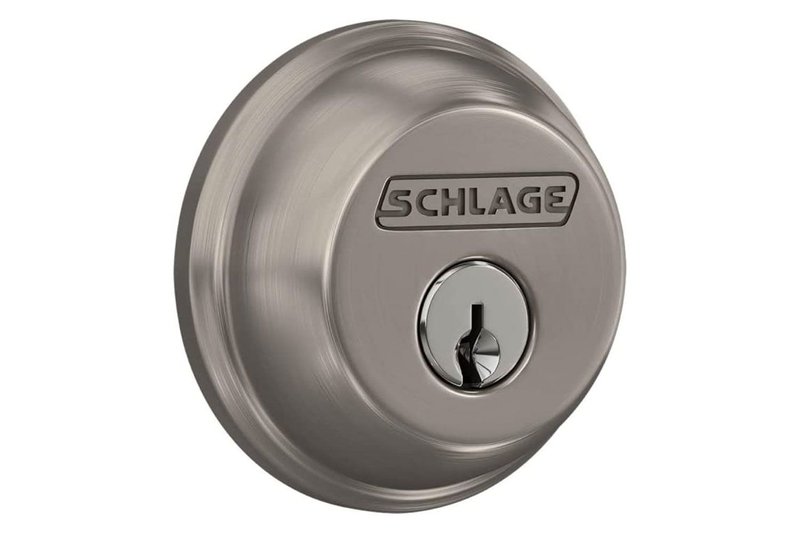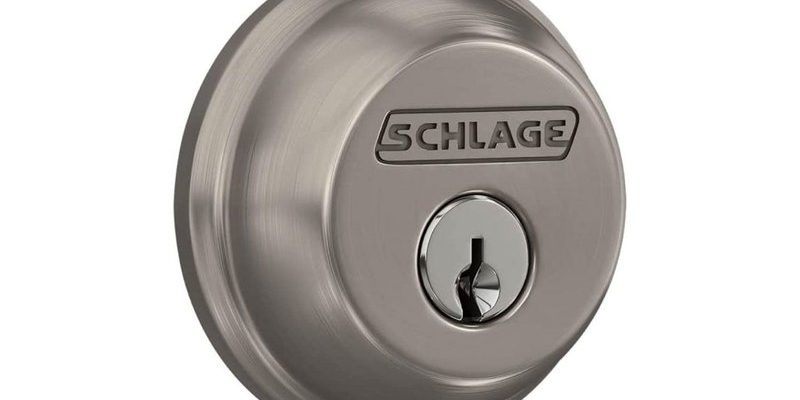
Let’s say you have a beautiful old wooden door—classic, sturdy, and warm. Or maybe your builder installed a modern steel or fiberglass one for extra insulation and strength. The best deadbolt for wood might not work so great on steel, and vice versa. Not all deadbolts are built to handle the unique demands of every door material, and you don’t want to find out the hard way that yours isn’t up to the job. Let’s break down how to match the right lock with your door, plus a few notes on top brands and what really makes a deadbolt the “best” for your setup.
What Makes a Deadbolt “Best” For Your Door Material?
You might be wondering, “Why does door material even matter when picking a deadbolt?” Here’s the thing: every door material holds hardware differently, responds to force in its own way, and needs a lock that works with its unique structure. Think about trying to screw a heavy-duty shelf into drywall versus solid wood—the material changes everything.
Wood doors are usually pretty forgiving but can splinter if a lock isn’t sized right. Steel doors are tough but can bend or dent, especially if the hardware isn’t meant for metal. Fiberglass doors can crack or flex, so you have to be careful about torque and pressure points. The “best” deadbolt isn’t just about strength or price—it’s about compatibility, reliability, and longevity.
When choosing, keep in mind:
- Lock compatibility: Some deadbolts come with templates or mounting kits for specific door materials. Don’t skip this—it saves tons of frustration.
- Security ratings: Look for ANSI ratings (Grade 1 is the strongest). But remember, a Grade 1 deadbolt in the wrong door can still be a weak spot.
- Ease of installation: If you’re a DIYer, check for guides, pre-drilled holes, and whether you’ll need special tools—especially for steel or fiberglass.
- Weather resistance: Exterior doors face rain, heat, and humidity. Go with a deadbolt finish that resists rust and corrosion.
Most top brands like Schlage, Kwikset, and Yale offer models designed for different door types. Matching the model to your door isn’t just a line in the instructions—it’s the difference between real safety and a false sense of security.
Best Deadbolts for Solid Wood Exterior Doors
Wooden doors are classic for a reason. They’re solid, easy to cut into for installation, and usually hold hardware firmly. But they can swell, shrink, or crack with changes in weather, which means your deadbolt needs to allow for a little wiggle room—without compromising security.
Honestly, when you’re working with wood, you have the widest selection. High-security options like the Schlage B60N or Kwikset 980 work beautifully here. These deadbolts are ANSI Grade 1, giving you outstanding resistance to forced entry. The catch? You need to drill carefully and follow the template exactly. Too tight, and the wood might split. Too loose, and the deadbolt can wiggle in the pocket, making it easier to kick in.
If you like tech, smart deadbolts like the Yale Assure Lock SL are also a good fit for wood. They’re typically designed with adjustable backsets and come with clear instructions for wood installations. Just make sure your door’s edge isn’t too thin for the motorized components—read the minimum thickness spec before you buy.
You might be tempted by double-cylinder deadbolts (keyed both sides) for extra security, but beware: some fire codes don’t allow them on main entry doors. If you need remote code access or pairing with smart home systems, stick to established brands. Watch out for knockoffs that look tough but are held together by flimsy screws or low-grade batteries.
Best Deadbolts for Steel Exterior Doors
Steel doors ramp up security right out of the gate—they’re already tough to break through. But here’s what catches people by surprise: installing a deadbolt in steel isn’t as easy as drilling through wood. You need a deadbolt made for metal, with reinforced mounting plates, and often a specific installation kit.
Strong choices here include the Medeco Maxum and Schlage B660P models, which are both built to handle the rigidity of steel. These models come with extra-long screws, solid metal strike plates, and clear guides for working with metal surfaces. If you go the DIY route, use a hole saw specifically for metal, and take your time. Rushing can warp or dent the door, which affects how the deadbolt lines up and functions.
Steel doors are less forgiving if you mess up the cut, so measure twice (or three times). The most common troubleshooting issue? Misaligned lock holes, which can cause the deadbolt to stick or not fully extend. Don’t ignore this—an unpaired or half-retracted bolt is an open invitation for trouble.
Electronic deadbolts with code pads or sync options (think Kwikset SmartCode 914 or Schlage’s Connect series) can also work great if they’re designed for metal. Just check that wireless remotes or app connections (Bluetooth, Zigbee, etc.) don’t struggle with the door’s thickness or material, as steel can sometimes block the signal.
Best Deadbolts for Fiberglass Exterior Doors
Fiberglass exterior doors are the new go-to for homeowners wanting durability with less weight. They do a good job at resisting dents and weather, but they can be somewhat tricky when it comes to hardware like deadbolts. You have to be careful not to overtighten, as fiberglass can crack or deform under too much pressure.
For fiberglass, look for deadbolts that spread pressure over a larger area. The Schlage Encode is a good bet because it comes with well-designed mounting plates and smooth operation (which means less stress on the door). The Yale Real Living Touchscreen Deadbolt is another solid choice, offering secure code syncing and smart features, while staying lightweight enough for fiberglass.
Many fiberglass door manufacturers provide reinforced “lock blocks” in the core, so make sure your deadbolt lines up with these. If you’re upgrading from a basic lock, double-check the internal structure before drilling—some doors need special reinforcement kits. Otherwise, your new deadbolt might end up feeling loose, or worse, pulling through with enough force.
When troubleshooting issues on fiberglass, the most common problems are stripped screws and remote battery drains (for smart locks). Always use the manufacturer’s screws, don’t overtighten, and keep an eye on battery levels if your lock has syncing or remote features.
Comparing Universal vs. Brand-Specific Deadbolts
You might see a lot of “universal fit” deadbolts online or at the hardware store, promising to work with any exterior door. But do they really hold up against specialized, brand-specific models? Let me explain the real difference.
- Universal deadbolts come with adjustable backsets and mounting hardware for wood, steel, and fiberglass. They’re great for quick installs, rental properties, or if you’re not sure what door you’ve got.
- Brand-specific deadbolts (like specialized Schlage, Kwikset, or Yale models) are tested and certified for particular materials. You get heavier-duty strike plates, better instructions, and often extra security features tailored for your door’s structure.
In practice, universal deadbolts are fine for basic wood doors, but on steel or fiberglass, they often feel a bit wobbly or underpowered. You might have to add extra reinforcement, or the lock body might not pair securely with the door’s surface. For top security—and less code or connection troubleshooting—stick with a deadbolt that’s matched to your material.
If you’re not sure which type you own, check for brand and model numbers on your existing lock. Even a quick online search with your door’s brand plus “deadbolt pairing” can save you a ton of headaches.
How to Properly Install a Deadbolt Based on Door Material
No matter which deadbolt you pick, the installation makes all the difference. Here’s how to do it right for each material—no shortcuts.
- Wood doors: Use sharp hole saws and spade bits. Go slow to avoid splintering. Always use the template provided by the deadbolt brand.
- Steel doors: Mark everything carefully, then use a metal-rated hole saw. File rough edges and test-fit before final mounting. Reinforce with longer strike plate screws for added security.
- Fiberglass doors: Pre-drill pilot holes and use only the included screws. Don’t overtighten. If your door has reinforcement blocks, aim for those. Avoid cheap or universal deadbolts unless they specify fiberglass compatibility.
Even pros run into trouble when pairing the wrong lock with a tricky door material. If you run into resistance or the deadbolt sticks, stop and double-check your alignment. Remote or smart deadbolt not syncing? Make sure the batteries are fresh and the door’s material isn’t interfering with the signal.
Key Maintenance Tips for Deadbolts on All Door Types
After all the work of picking and installing the best deadbolt, it’s easy to forget the last step: regular maintenance. Here’s why it matters. Dust, moisture, and even battery issues (for smart locks with remotes) can all cause trouble—sometimes right when you need your lock the most.
For wood doors, a yearly check for alignment is smart. Wood expands and contracts with humidity, and sometimes you need to reset or adjust the strike plate. For steel doors, lubricate the bolt and check for rust around the hardware. If your steel door gets dented, that can throw off the code or pairing on electronic models. For fiberglass doors, keep an eye out for cracking or pressure marks around the deadbolt. If your lock starts to feel loose, troubleshoot right away—don’t wait until you’re locked out.
Battery-powered deadbolts should get a fresh set every six months or so. Some brands even include battery indicators or remote alerts, which can save you from a late-night lockout.
Final Thoughts: Matching Deadbolts to Your Door Is Worth the Effort
Choosing the best deadbolt for your exterior door material isn’t just another thing on your to-do list—it’s really about making sure your home stays safe and your locks work the way they’re supposed to. Wood, steel, and fiberglass each bring their own quirks to the table, and the right deadbolt makes a huge difference in comfort, security, and peace of mind. Take your time, match your deadbolt to your door, and don’t skip those manufacturer tips or troubleshooting guides. When it all lines up, you’ll know your lock is a true match for your door—and your security needs.
